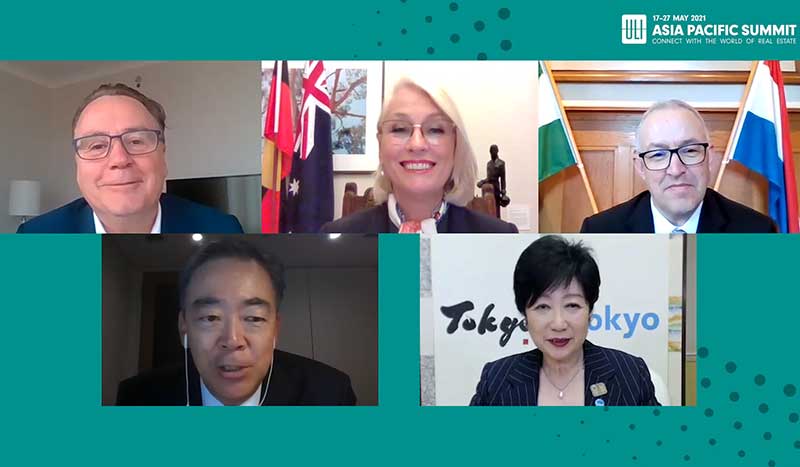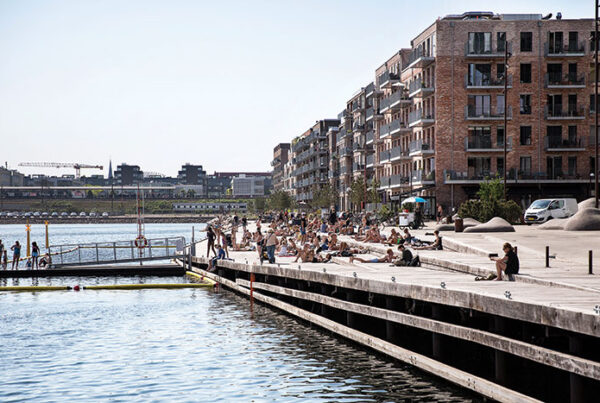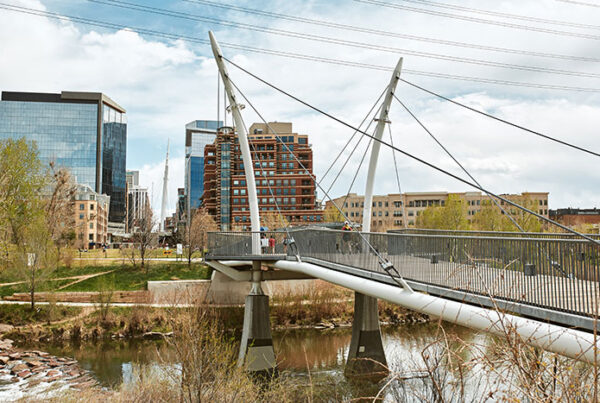Reducing carbon emissions, revitalizing city centers, and empowering communities to drive a sustainable recovery are the key challenges for leaders of world cities.
During the 2021 ULI Asia Pacific Summit, the leaders of three of the world’s most dynamic cities were interviewed—Yuriko Koike, governor of Tokyo; Sally Capp, lord mayor of Melbourne; and Ahmed Aboutaleb, mayor of Rotterdam—to learn about the past year and their plans for the future.
Moderator Greg Clark, group adviser on future cities and new industries at HSBC, said that city leaders have had an extraordinary role over the past 12 months, trying to make cities safe while allowing business to continue as much as possible, all the time with an eye on the post-pandemic urban recovery.

Clockwise from bottom right: Yuriko Koike, governor of Tokyo; Hiroo Mori, director and executive vice president, Mori Building; Greg Clark, group adviser on future cities and new industries at HSBC; Sally Capp, lord mayor of Melbourne; and Ahmed Aboutaleb, mayor of Rotterdam, speaking at the 2021 ULI Asia Pacific Summit.
Koike said that Tokyo is focusing on a sustainable recovery, after suffering relatively lightly during the COVID-19 pandemic, with “sustainable recovery” being the key notion. “We need to achieve sustainable recovery and sustainable growth in all areas of Tokyo’s policies, so that we can evolve into a city where everyone can live happily and with peace of mind,” she said. This involves more people-centered, walkable development and an acknowledgment that Tokyo is not just the business districts in the heart of the city but its islands and nature-rich areas.
As part of the Paris Agreement, Tokyo has introduced a cap-and-trade scheme for carbon emissions in order to reduce the carbon footprint of the city, which has committed to reducing carbon emissions to 50 percent of 2000 levels by 2030. Koike also said she hopes that Tokyo can become an international center for green finance, attracting overseas asset managers and financial technology companies.
Melbourne suffered one of the longest city lockdowns during the pandemic, which was “devastating,” said Capp. However, the crisis brought government bodies together, enabling cooperation and rapid action. For example, Melbourne accelerated the delivery of 40 kilometers (25 mi) of protected cycle lanes, originally scheduled to be delivered over an eight-year period, in addition to permitting more outdoor dining to support local businesses.
In the future, Melbourne is looking for “big city-shaping projects that create economic stimulus, but also have a long-term legacy for the city and the community,” she said. A key lesson of the pandemic was about the importance of public open space and community uses. As a consequence, there will be more community input into future plans.
Capp said her administration is still studying the impacts of the pandemic and learning the impact of the pandemic on employment, workstyles, and thus the built environment in the city, she said, but added: “We feel very confident that people will still come to the city to work.” Office vacancy rates have risen, she said, but that has allowed growing startups to find affordable space in the city.
One positive from 2020 was the “tremendously high level of social solidarity in the city,” said Aboutaleb. However, the pandemic revealed gaps in its disaster planning, which are being addressed with a new institute. Rotterdam is committed to a greener future, and Aboutaleb has earmarked €300 million ($365 million) for new green spaces, which he hopes will attract businesses and further development.
Aboutaleb said he expects less use of downtown office and retail space, which could be repurposed for more housing, in order to create a better balance of living, working, and leisure uses in the city. The city has commissioned a national research institute to examine the city’s future needs and where best to develop.
As part of its commitment to sustainability, Rotterdam is working on an ambitious plan to capture carbon emissions from the city’s port and associated industries and send them in a pipeline to the North Sea, where they can be pumped into former oilfields as part of a carbon sequestration plan.
But panelists agreed that further innovation and investment are needed to make the world’s cities more attractive and sustainable for the future.



